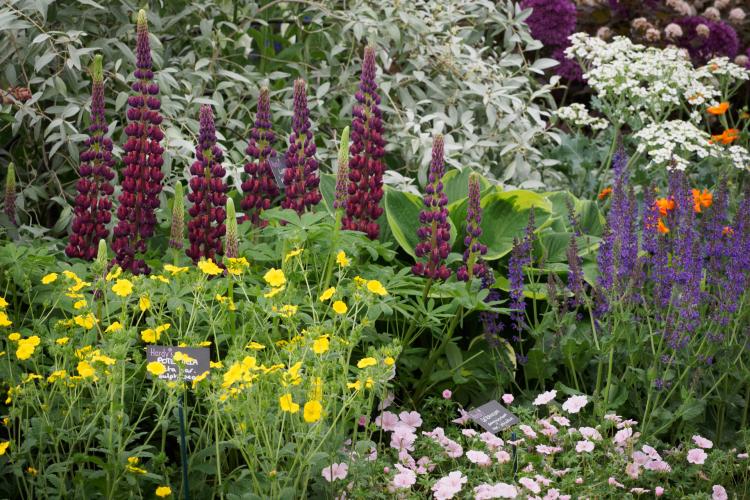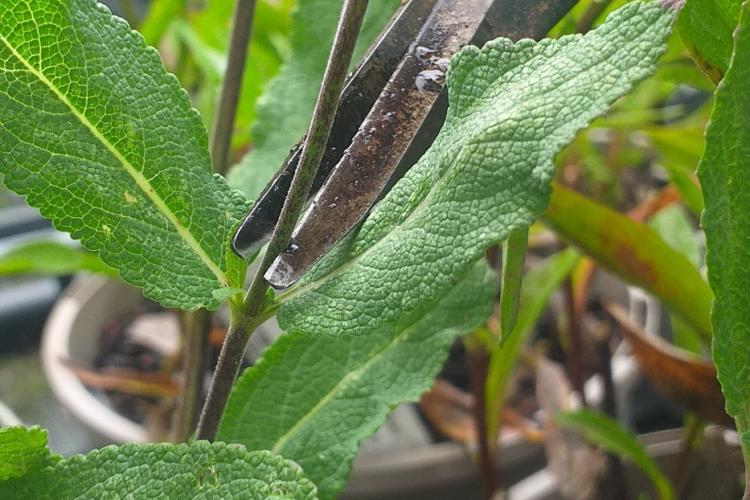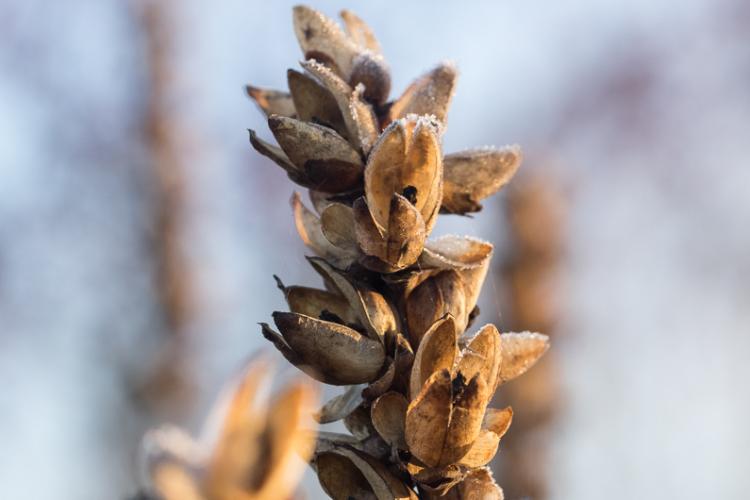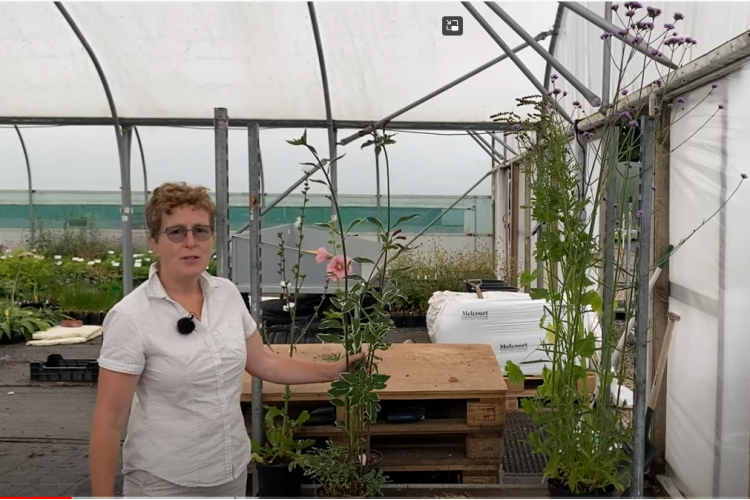Staking perennials
Why, when and how to stake plants is a thorny issue for lots of gardeners, but here we will try to clear away some of the confusion.
Avoidance: Limiting the number of plants that need to be staked is always a good shout as it’ll leave you more time to get on with other things.
Firstly, take care with the placement of your plants. Sun loving plants placed in too much shade will stretch and lean trying to find the light they crave, always look at the requirements of your plants before placing them and never try to force a plant into conditions to which it is not suited.
Don’t overfeed: Soils that have been overfed or are rich in nutrients will promote fast soft growth leaving plants vulnerable to wind, rain and the extra weight caused by excess growth.
If you have a bed that is exposed to the harsher elements then use plants that revel in such conditions, prairie style planting suits these sites well. Eryngium x zabelii ‘Big Blue’, Salvia ‘Indigo Spires’, Phlomoides tuberosa ‘Amazone’, Rudbeckia triloba ‘Prairie Glow’ and Verbena bonariensis are just a few suggestions you might like to consider.
Depth of soil: Some plants need to root deeply to anchor themselves in place and to find the correct amounts of water and nutrients to grow well. Taller plants in particular, rarely do well in shallow soil as they are likely to collapse due to insufficient root anchorage.
If you really desire a plant that is going to be at danger of succumbing to these pressures then look for more compact forms to make things easier. Coreopsis ‘Daybreak’ Polemonium ‘Blue Pearl’, Amsonia ‘Blue Ice’ and Dianthus carthusianorum may well help.
Spacing: This is all about researching your plants carefully. Look at the ultimate spread of the plant and allow it that space. Plants that are too close together can grow weak and leggy as they strive to get light. On the other hand, don’t plant too far apart. Plants can support each other to an extent, particularly if you place the taller perennials adjacent to stronger woodier plants and shrubs. Also, by leaving too much space between plants you encourage weeds, and allow the soil to dry out in the heat, thus depriving your existing plants some much needed moisture.
When and How: With careful research and planning you will hopefully have reduced the number of plants needing to be supported. However, some need for support may be unavoidable.
Timing is important for preventative staking and you need to work early. This is to allow your plants to grow through the supports, without damaging them and also helps to hide the supports from view. This is particularly relevant with grids or hoop stakes. Twiggy sticks can be pushed into the ground around lower growing plants like Penstemon and will add extra woody structure that won’t be seen.
Individual bloom supports in the form of small rings or Y shaped stakes need to be in place by the time the flower buds start to swell.
Many materials you produce in the course of gardening can be utilised, such as last year’s pruning from shrubs and trees, even branches from old Christmas trees can be put to good use. You will also need twine or cushioned twisty tie . Please don’t use wire or bag ties as they can cause damage to the plants. Tie in loosely to allow for growth and also to enable the plant to move and flex. Use a figure 8 by tying around the support then crossing the ends over and tying around the plant stem. This will stop the stem rubbing against the support. You can also make frames or cages round the plant to enable it to fill out while still being supported
. 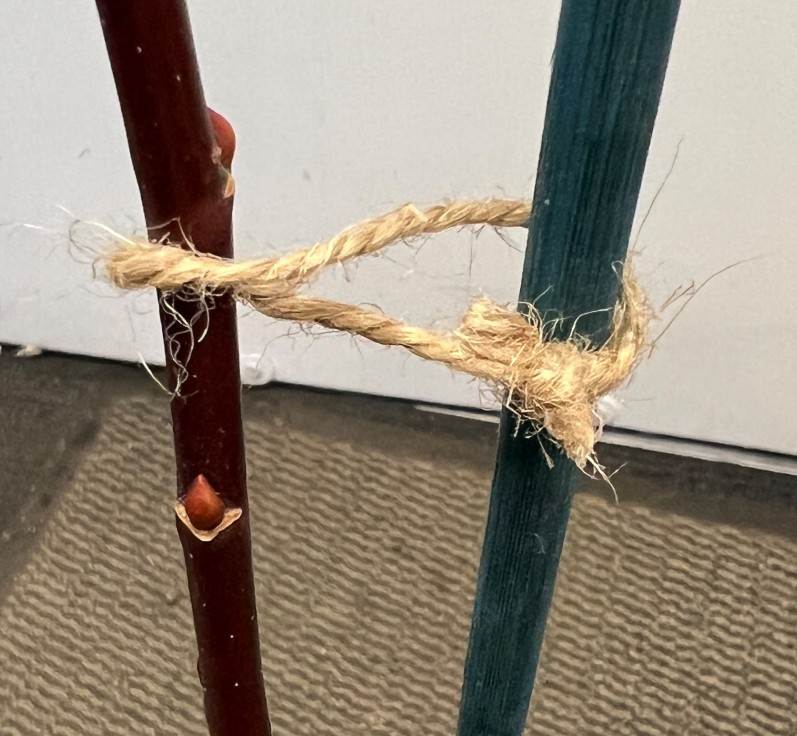
Usually the main force of support is applied to the middle or higher parts of the plant and extra tying in may be required, as the plant grows taller.
Ideally the aim is to support the plant without the support becoming obtrusive. There are however, some beautiful wood, metal or basket woven, cones, obelisks and pyramids that can be incorporated to great aesthetic effect.
Waiting until the plant is starting to suffer will inevitably have caused damage to the plant and maybe others around it.
Remedial supports: These are used when the damage has already begun, to prevent further problems and may be needed after rain, hail storms or high winds and should be used at the earliest opportunity. Plants that have fallen over will grow upwards towards the sun, very quickly creating an elbow like change in direction to the stem. Once set, this will never fully straighten even after the plant is supported, so this kind of repair should be done as soon as it is safe to do so.
Using bamboo, wooden or metal canes has an inherent risk of injury should someone fall onto them or poke themselves while bending to inspect a plant. Cane toppers are available should they be needed, but a small upturned pot placed on the top of the support will help mitigate any danger. Ideally, they would never be placed near the front of a bed anyway.
Remember to deadhead plants to encourage new buds if possible, and also to reduce the overall weight of taller plants.
Finally remember to remove your supports when no longer needed as they can deteriorate or rot if left in wet soil during Winter.
Some of the plants that most often need staking.
Herbaceous Paeony – you could try planting intersectional or tree Paeony instead as both types develop a woody and more supportive structure. If you have a Paeony that droops when in flower use a ring or Y shaped support under each bud as they start to swell.
Dahlias – There are many shorter varieties available now which are unlikely to need support, but some of the taller and heavier flowered types will certainly need some help.
Lillies – There are short and tall forms to choose from and placing them carefully could negate the need for support.
Sunflowers – These plants, given full sun, deep soil and protection from wind, will mostly be fine. Some of the giant varieties will need strong supports as they grow.
Rudbeckia – These spreading plants can collapse if they are planted without other tall plants or if they are in too small a space. Light deprivation for part of the day often causes them to lean and stretch. .
Hylotelephium (Sedum) – These plants can often collapse out wards under the weight of their own flowers and seed heads. Cutting each stem back by half at the end of May will encourage side shooting and therefore more flowers, but the decreased stature will lessen the likelihood of late season collapse.
Many perennials will lose vigour, particularly in the centre, after a few years, as the plant grows into a larger clump. Lifting and splitting these plants, during their dormant season, will give them new vigour and help prevent any outward collapse.

